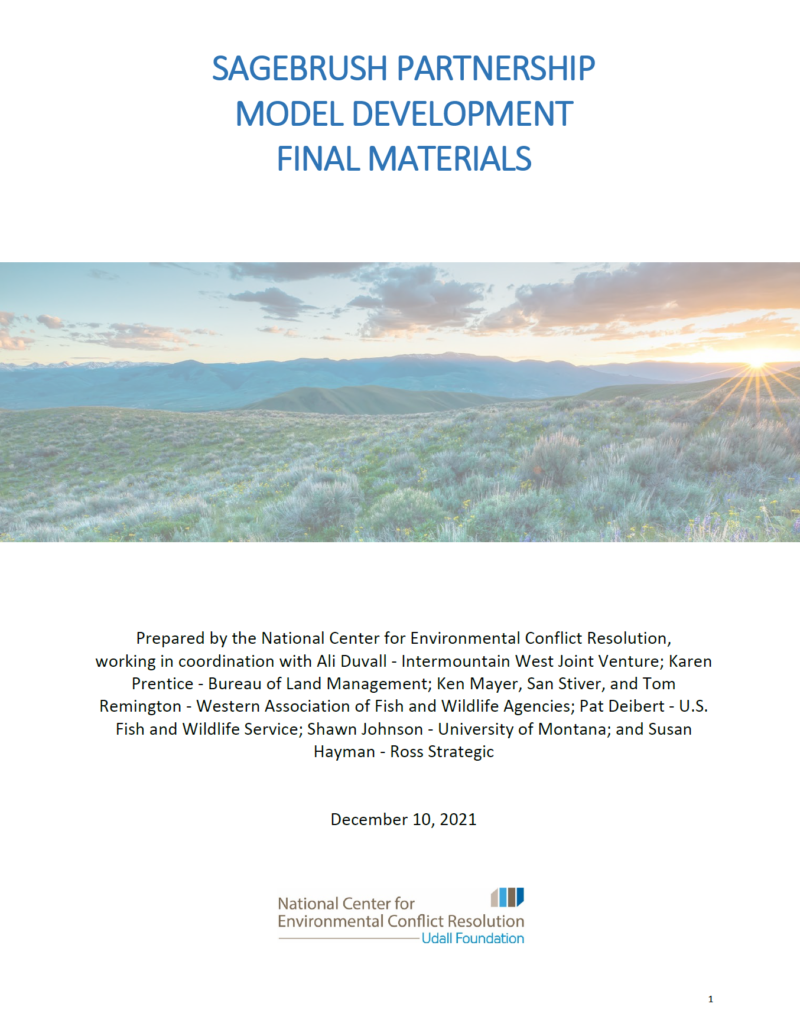The Western Association of Fish and Wildlife Agencies (WAFWA), in partnership with Bureau of Land Management (BLM), U.S. Fish & Wildlife Service (USFWS), U.S. Geological Survey (USGS), Intermountain West Joint Venture (IWJV), and other key conservation partners is developing a Sagebrush Conservation Strategy (Conservation Strategy) to guide collective efforts to conserve the sagebrush biome.
As part of these efforts, the National Center for Environmental Conflict Resolution (National Center), working in coordination with a Core Team consisting of representatives from WAFWA, IWJV, BLM, USFWS, and the University of Montana, conducted a situation assessment (Sagebrush Biome Partnership Governance Assessment) of individuals from NGOs, user groups, and Tribal, Federal, and State agencies to identify the needs, issues, priorities, and obstacles associated with sagebrush biome partnership. Not surprisingly for such a diverse group, support for a partnership governance structure ranged from strongly enthusiastic to opposed, but the most common response was supportive with caveats. Caveats primarily focused around respecting jurisdictional authorities and maintaining local autonomy. Other themes heard from assessment interviewees highlighted the need for continuity, increased and dedicated resources and staffing, the need for broad participation at all levels, and coordination across scales, the need to build on successes while also leaving room for innovation, and attention to data, monitoring, and landscape prioritization.
The National Center also completed a research report (Review of Models for Sagebrush Biome Partnership Governance) that reviewed and provided lessons learned from other large landscape collaborative governance models. Lessons learned from successful partnership models included attention to goals and measurable impact - having a compelling vision and agreed-upon quantitative goals that are viewed within the larger system context to appropriately evaluate their success. In addition, successful partnerships have an effective system to track and report on progress as well as adjust goals and management approaches over time, balanced and inclusive representation, access to needed knowledge and scientific or technical information, sufficient and sustainable funding, dedicated leadership and staffing, a structured approach to decision-making and conflict resolution, attention to relationship building and incentives for involvement at all partnership scales. Following the assessment and research reports, facilitation team members from the National Center and Ross Strategic guided sagebrush biome stakeholders and Tribal partners through a collaborative process from March to July 2021 to develop the potential partnership models best suited for conservation efforts in the sagebrush biome.
Building on these results, three partnership model options were generated by the collaborative process. The first partnership model option is a Governor-Convened Representative group at the biome level consisting of representatives appointed by the executive level of State and Federal wildlife agencies, NGOs, industry, and Tribal Nations. The second partnership model option is an NGO partnership, composed of a biome-level coordinating group with an NGO as the convening entity. The third partnership model option is a Federally led Coordination Committee with Federal agencies from USDI and USDA as joint conveners of a biome-level coordinating body and states helping to set priorities. Elements in common across all partnership model options include tribal engagement, diverse representation, engagement of different levels of representation, sufficient funding and staffing, and science, technical, and communications support. The three partnership model options, and the process leading to their development, are outlined in this package.
The participants in the partnership models development process have expressed the hope that these products will be a springboard for further discussion among the larger sagebrush community about the formation of a collaborative partnership, followed by decision-making around forming such a partnership.
Prepared by the National Center for Environmental Conflict Resolution, working in coordination with Ali Duvall - Intermountain West Joint Venture; Karen Prentice - Bureau of Land Management; Ken Mayer, San Stiver, and Tom Remington - Western Association of Fish and Wildlife Agencies; Pat Deibert - U.S. Fish and Wildlife Service; Shawn Johnson - University of Montana; and Susan Hayman - Ross Strategic
Attached Files
| File | Action |
|---|---|
| Sagebrush Partnership Final Materials Package v8.pdf | Download |
- Version
- File Type pdf
- File Size 11.75 MB
- Publication Date December 10, 2021
